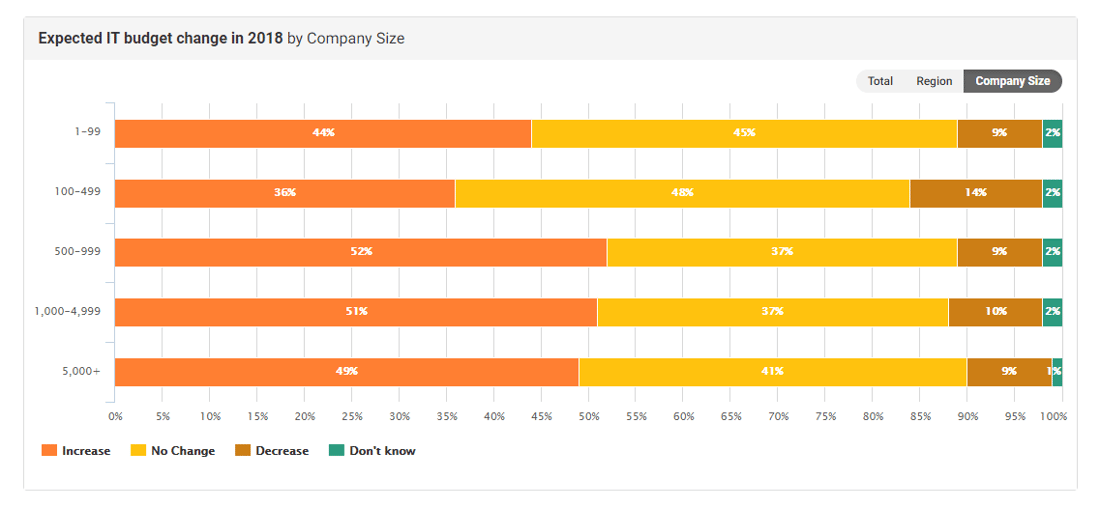
Having a well-organized IT budget is essential for small businesses to succeed in the world. The questions are, how much should an IT budget be in a business? And how do...
Small business leaders don’t often want their business to stay small.
Continued growth and greater revenue are what makes small- to medium-sized businesses tick. The ability to grow and scale is a must to meet and exceed revenue goals.
The role of information technology (IT) plays an increasingly critical part of scalability. It is especially essential to growing businesses.
Before small business owners can lay out a budget, it’s helpful to understand how an IT partner can help small businesses leverage IT as a competitive advantage in their business. It really is impossible to plan and budget IT without a clear understanding of how IT impacts your business and why an IT strategy partner (yes, even for small businesses) can impact your ability to outperform the competition and gain the maximum efficiencies with the limited budget you have to work with. A strategic IT partner will help you plan and budget for the following:
All budgeting matters. This is no surprise.
But IT budgeting is critical because over the long-term it can become prohibitively costly. It helps to think of IT budgeting as a proactive investment. You want to set aside a budget in case technology breaks down, technology needs to be upgraded or new purchases are required. In a world of constantly changing and improving technologies (AI, machine learning) you and your team also need to be forward-thinking in your ability to adopt new services such as Office 365 and other cloud applications that can save considerable time and increase productivity. The price tags on these fixes and necessary technologies could really impact the bottom line when you don’t expect it. For example, when an old server needs replacement, you have choices. Before the days of the cloud, your only choice was to buy an expensive server and upgrade all the software to work with the new server. This would cause big out of pocket expenses for hardware upgrades and force upgrades in software and patches. Employees would have to stop what they are doing and allow an in-house or outsourced IT partner to make all the necessary upgrades. Both time and money would play a considerable role in ensuring everything connected to the server ran smoothly but also that the employees could continue to access vital applications to continue to perform their duties without time loss and gaps in access to data that play a key role in servicing your clients.
Today, cloud products such as Office 365 and other cloud-based applications can eliminate the need to purchase expensive servers and disruptions in downtime due to set-up and updates that used to be considered normal business. However, not everyone is ready to move to the cloud and having a cloud “plan” in place will help you determine what and when is the best time for a move that can be budgeted and planned. Working with a trusted IT advisor will help you plan for challenges in cloud performance and different subscription offers that the average business owner simply would not think to consider. Planning a technology refresh can save considerable time and money but requires just that, planning and the best place to begin is with a provider who knows technology and will minimize the transition.
Another reason to budget IT in advance is that many small business owners focused on continued growth are most often focused on budgeting for sales, operations, and service. Truth be told, IT costs rarely top the list.
The daily realities of break-fix will likely take up so much time that there will be little left over for the necessity of strategic upgrades and purchases – which is a necessity. Without an IT budget which often follows some type of IT planning on how you want to use that equipment and infrastructure, the IT spend not budgeted for will take away or cut into your budgets for sales, operations, etc.
Technology will inevitably become obsolete. Why? It is advancing at a rapid pace. What this means to a small business is that business applications such as Microsoft Office, Outlook, anti-virus/anti-malware, firewall updates or simply line of business applications get too far behind in updates and patches which causes a ricochet of events that directly impact everyday operations and productivity. The first impulse of a small business with limited resources is to conserve money, so a desktop or server that still works – turns on and runs applications – even after its projected end-of-life is probably not going to go away.
So, when you have a problem, call your vendor, only to learn that they no longer support that version of your software. Now, what do you do? Typically, there is no other choice but to upgrade and that is when you learn your version is too old and does not have an upgrade path to the current version. *Sigh* This now requires that you go through multiple upgrades that often bring huge disruptions to your everyday workload and costs considerably more than if you would have simply planned a path for upgrades and possibly technology that would have saved you money.
The Security Cost You Might Not Have Anticipated
It is estimated that 25% of business systems contain an average of 700 unpatched vulnerabilities. As a result, 14 million small businesses – half of all US small businesses in total – are vulnerable to hackers, and may have already been breached. Even if you aren’t worried about vulnerabilities, the fact remains that out-of-date infrastructure will be slow, and lack features that up-to-date workplaces take for granted. This, in turn, will slow down your workers’ productivity, which will slow down their ability to respond to customer demands. This will inevitably accelerate customer churn. In other words, if you don’t layout an IT budget that can evolve with your business, your failing IT architecture will probably keep your small business from becoming a big business.
We understand that it’s not easy for any business -- especially smaller ones with potentially tighter budgets -- to proactively set aside dollars for emergencies, but there are ways to do so strategically and economically.
Why: An outside IT partner will ensure your IT architectures aligns with your business needs (aka the way you do business.) In other words, they will ensure that your organization possesses right technology that performs with the features that your workers need to excel – all while keeping inside your budget. An additional benefit of partnering with an outside IT partner is the fact that they fulfill the job and skillset of a full-time employee without requiring the cash layout and management of an employee. IT partners like Microtech provide your business with high-level planning and tactical expertise specific to your needs as well as the needs of the industry. It’s a real “win-win.”
Why: Know what you own. How is your data organized? What type of disaster recovery plan in place if your systems are hacked or suffer from a real disaster that shuts down operations? Do you have the right firewalls and AV implementation to keep your team productive and your data secure? What happens when your equipment reaches the end of life? Is there a more cost-effective plan? Thinking through these types of scenarios and questions present cost savings, longevity, value, and ROI. This will help you in vendor negotiations and in planning ahead for what is needed.
Why: The obvious answer is if you set money aside, there will ideally be no monetary surprises that set you back, or to put you in a bad situation when it comes time to replace, update and possibly move to a new technology (such as the cloud) and you can’t afford these upgrades, leaving you vulnerable to all the potential costs and security risks mentioned above Technology partners that help you plan and budget will help you build a plan and continue to review that plan on several different occasions, so that when it comes time to make a change, you are able prepared. What you don’t know really will hurt you. Most small business owners don’t realize that they consistently overpay for technology that won’t do exactly what they need it to do and they buy technology they don’t really need. Working with a professional IT partner can help you plan now and save significantly more later.
Why: However, you choose to create your IT budget and how it fits in with the rest of your business operations, be sure it is consistent. Unless measurable in the same fashion year-over-year, it will be challenging to find trends that point to either successes or failures.
IT budget planning and strategy are all well and good, but it’s the numbers that matter most. Unfortunately, there is no hard and fast rule for determining an IT budget. Different IT budgets are required of different businesses. Factors like industry-types, security standards, employee and client needs will vary.
But here’s what we can tell you. According to IT research and advisory firm Gartner, as of the first quarter of 2018, IT spending is an average 6.2% of total budgets on average worldwide.
Spiceworks, a professional network that provides resources to IT professionals, reports that about 44% of small businesses can expect an IT budget increase in 2018. However, as experienced IT partners to local SMB – who help businesses budget and plan for IT changes - we at Microtech advise our clients to budget between 1% - 1.5% of gross revenue to keep up with evolving changes in the technology landscape and to help small businesses leverage technology to do more with fewer resources.

There are other options available. And they are especially appealing to small business owners aiming to save time and money. Making these kinds of IT budget decisions demands knowledge, experience, and practical know-how. But the cost of hiring a CIO or CTO could easily knock out your entire IT budget. What’s a company to do with a key executive hire that has zero budget to spend on hardware or software, let alone any innovative technologies?
MicroTech Systems solves this challenge by providing virtual CIO assistance that’s affordable. Sound too good to be true? It’s not. Here’s how we do it:
MicroTech systems deliver an achievable IT budget centered around a plan designed to help you budget for IT based on your needs today and into the future. We believe so strongly in the process that we are willing to offer a free IT Budget consultation to help you get a grip on IT costs, the impact of technology on your business and better ways to leverage what you already in place today. Actionable insights help you leverage IT success, scale your business, and see greater returns. Sign-up to reserve you’re your IT Budget Consultation.

Having a well-organized IT budget is essential for small businesses to succeed in the world. The questions are, how much should an IT budget be in a business? And how do...

It is always crucial for businesses to make the most out of their budgets. IT is no exception. Whether you run a small start-up or a large corporation, efficiently...